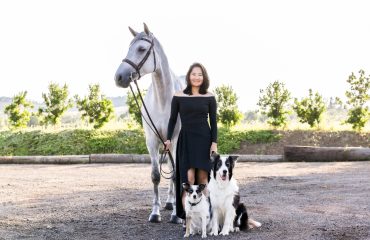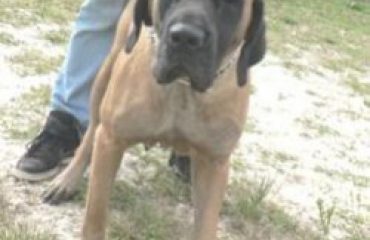
Boyd Martin riding Gloria Callen’s mare Welcome Shadow
Photo by Amber Heintzberger
Well known for both his fun-loving approach to life and his indefatigable work ethic, Boyd Martin has represented the U.S.A. in three-day eventing at two Olympic Games and two World Championships, and was on the gold-medal-winning Pan Am Games team in 2015. Boyd’s wife, Silva Martin, is a grand prix dressage rider and they have a son, Nox. Boyd and Silva train out of their own farm, Windurra USA in Cochranville, Pennsylvania, and spend winters at Stable View Farm in Aiken, South Carolina.
How do you mentally prepare for a competition?
I truly believe that competing cross-country is 75 percent physical and 25 percent mental. There’s no question in my mind that as long as they are prepared physically, a rider can get around a cross-country course that is challenging if their mind is in the right frame. On the other side of that coin, I think a rider can fail due to overthinking and not being able to mentally deliver in the moment.
Many years ago, when I was riding for Australia, every rider had to work with a sports psychologist. To start with, I thought it was a bunch of baloney, but I did want to represent the country so I went along with it and I learned a number of tips that have stayed with me for the long run.
The first thing is confidence. This is definitely a mental state and as riders we gain confidence by knowing that we are fully prepared for the course that we are about to attack. Confidence comes from preparation: knowing you and your horse have done the right amount of training and are prepared to face the level you are about to take on. There is comfort knowing that you and your horse have prepared: you’ve schooled all the types of fences, your fitness level is high and you truly believe that you belong at this competition.
The second thing is visualization. I always try before the event to block off a segment of time where I go into my own little world, my own quiet place, and visualize how I’ll ride each fence. You don’t want to let this become too consuming; when you’re really nervous, it’s possible to start analyzing all night and before you know it you’ve sent yourself crazy. I block off 30 minutes or so just before bed to envision how to ride each fence. ‘Seeing’ yourself ride well can help build your confidence, just don’t spend all night losing sleep over it! Sometimes it’s hard to visualize the whole course so you might visualize the first third of the course, then take a break — if you’re someone like me who has a hard time concentrating — and then visualize the next segment. This also applies to the dressage test, not just cross-country.
When you’re sitting on your tack trunk waiting for your ride time, it can be helpful to watch some top riders on YouTube and look at how they’re riding. Try to have the image in your mind of going out and riding just like them. You can really learn from watching your idols, and seeing them ride just before you head out on course can put a fresh picture of what you’re aspiring to in your mind.
One thing that can work for you — and can absolutely work against you — is some competitions have a live feed of the competition that you can watch. You can also go out on course and see how particular fences are riding. You might have an image in your mind of riding a combination and the first one you watch falls off, the second one chokes, and then you overhear someone say they’re definitely taking the option now. But usually your original plan is the right one, and if you see something ridden well, it can give you confidence that it’s going to be A-OK.
In your final warm-up, one thing I’ve learned from Phillip Dutton is we don’t want to make the warm-up too perfect. If you have a bad jump in the warm-up, it’s a good thing; you don’t want your first bad fence to be on the course, so sometimes getting a bad distance or struggling with your balance or distance wakes your senses up. If something goes wrong in the warm-up, be glad it happened there so you’re prepared when you go out on course. Many of my worst rounds have been after a perfect warm-up that didn’t wake me or the horse up.
I suppose the last thing is the “self-talk” just before you start. Be very positive and have a game plan, but good cross-country riding means being able to adapt and be open-minded enough to understand how the horse is going and how things are riding, and having the ability to get the job done even when it’s not perfect.
Having a good coach or mentor close by at the event is important, too. We’ve got to be careful that we’re not banking on these people too much, but at my biggest championships, I’ve had my mentor, Phillip, there going over the course before we start, giving me positive thoughts. Just when you start talking yourself out of going the direct route or going for the time, it helps to have someone urging you to go out and get the job done. And remember this: When it’s all done, you will probably wonder what you were so worried about.
How do you keep your horse balanced and off the forehand when galloping cross-country?
One of the important factors to consider when training your horse to go cross-country is the way the horse gallops between fences. To me, this is equally as important as teaching the horse to jump water, ditches and banks. When I’m schooling cross-country, the first section of my session would be galloping fences. I have a nice, big, flat field and I like to spend some time on single, galloping fences. If you think about a cross-country course, this type of jump makes up about 60 percent of the course anyway.
What I’m trying to encourage my horse to do is jump out of stride, and when he lands he should gallop away from the jump. Each horse will like to travel in his own way. Within reason, you’ve got to allow the horse to gallop along the way he’s comfortable. Ideally, his head should be up a bit and he should be carrying the bit forward lightly. I don’t like a horse that’s low in front, on his forehand and leaning on the bit. Similar to dressage, if he’s in this undesirable frame, I’d try to rebalance the horse and lift his head and front end up, get him to a place where I’m comfortable and then soften my hand and allow him to gallop on. Eventually he’ll learn he has to land, lift his shoulder and withers and gallop on.
Like all riding, it’s not all about the hand — you also need to squeeze with the leg and try to lift his whole balance uphill and lighter. It’s a combination of the lower leg, a little seat and a bit of hand. To simplify, it’s a very similar process to a half-halt in the dressage or show jumping but the speed might be faster and the horse in a slightly different balance. When you look around the world, the good cross-country horses at the moment are coming out of Germany and their riders have simple bits and bridles, often just an eggbutt snaffle and no martingale. These riders have done heaps of schooling and the horse is just gently balanced and turning and listening to the rider all in this soft uphill balance. Often this doesn’t come naturally so as riders we have to teach our horses to gallop softly and in balance.













